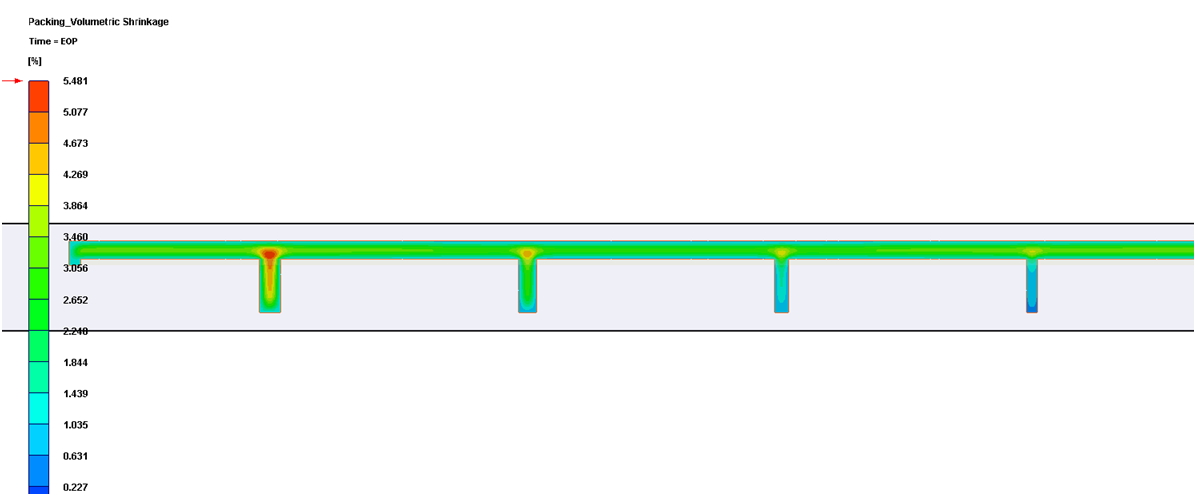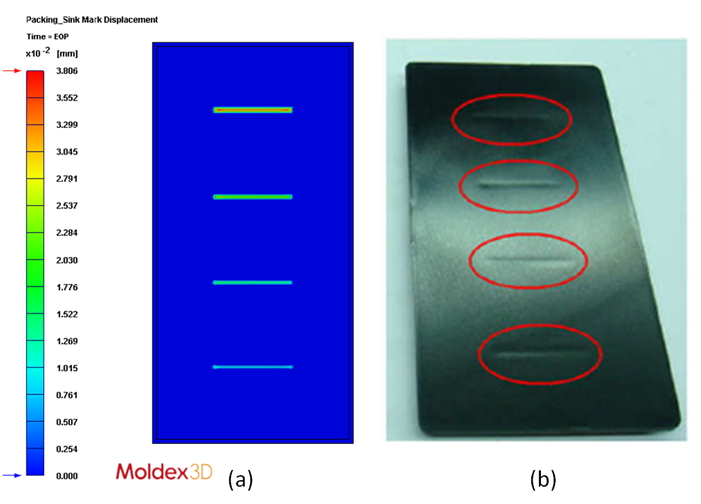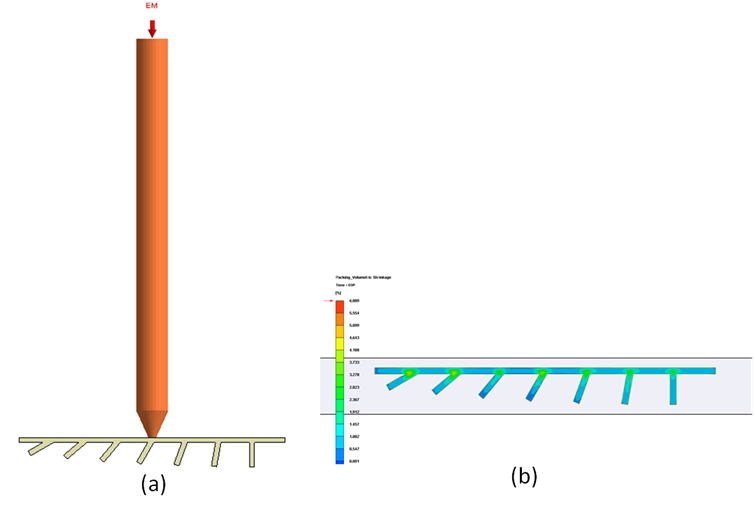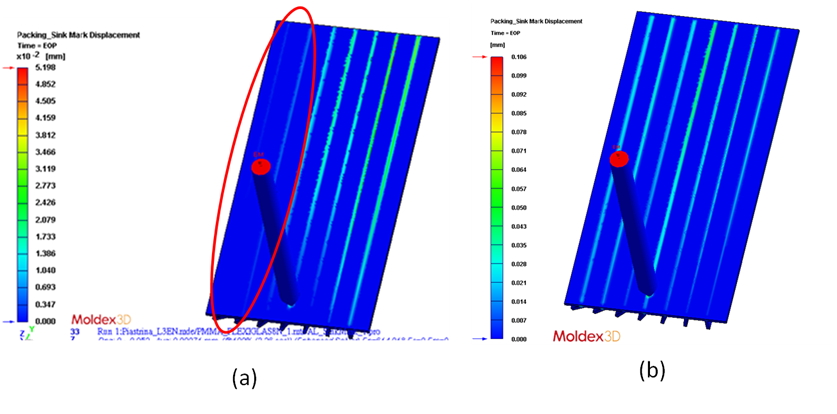The Enhanced Moldex3D’s Simulation Capability Provides Accurate Sink Mark Predictions for Complex Geometries
As the trend of plastic product designs moves towards smaller and thinner design concepts, it is important to strike a balance between the aesthetic appeal and the structural integrity when designing contemporary plastic parts. Ribs are often used to strengthen product mechanical properties; however, surface defects such as sink marks may occur due to uneven shrinkage caused by the varying thicknesses at the intersections of part surface and rib. In addition to the part geometry, the occurrence of sink marks is also closely associated with the packing conditions. Prior to the application of CAE technology, obtaining a set of optimized processing conditions to reduce sink marks heavily relied on trial-and-error and the experiences of the molders.
However, with the complexity of product designs and the fierce competition in today’s manufacturing world, the old ways of product development such as trial-and-error or relying on the experiences of seasoned molders no longer support the fast turnaround time demanded by customers. In order to tackle this sink mark issue head-on and reduce mold-trial costs, Moldex3D has introduced a useful simulation capability – Sink Mark Displacement Analysis. Moldex3D’s Sink Mark Displacement analyzes the sinking behavior in the packing stage based on the part geometry and the material used and accurately calculates the displacement values of surface sink marks. It truthfully captures the sink mark phenomenon of injection-molded parts and provides a valuable reference for product optimization and parameters adjustments prior to the actual production.
The following is a real case utilizing Moldex3D’s Sink Mark Displacement Analysis to predict the sink mark behavior. As shown in Fig. 1, the part geometry includes a flat surface with four different ribs of varying thicknesses. The thickness of each rib is 1.8mm, 1.5mm, 1.2mm, and 0.9mm, respectively.
 Fig. 1 Â The part geometry includes a flat surface with four different ribs of varying thicknesses.
Fig. 1 Â The part geometry includes a flat surface with four different ribs of varying thicknesses.
Based on the analysis of volumetric shrinkage in the packing stage, as shown in Fig. 2, the part’s flat surface exhibits an even distribution of volumetric shrinkage values. The volumetric shrinkage values, however, are unevenly distributed at the intersections of the part surface and rib. Thus, it is evident that the thicker the rib is, the bigger the shrinkage value will be, which further indicates a bigger chance of sink mark occurrence.
 Fig. 2  Moldex3D’s Analysis: Packing _Volumetric Shrinkage
Fig. 2  Moldex3D’s Analysis: Packing _Volumetric Shrinkage
Fig. 3 shows a clear comparison of Moldex3D’s Sink Mark Displacement Analysis with the observation of sink marks on a real injection-molded part. The result from the experiment shows that when rib thickness becomes thicker, sink marks appeal to be deeper as well.
 Fig. 3 (a) Moldex3D’s Analysis: Sink Mark Displacement; (b) The observation of sink marks on a real injection-molded part.(Ref: SIMULATON AND VERIFICATION ON PART SURFACE QUALITY USING EXTERNAL GAS-ASSISTED INJECTION MOLDING PROCESS, S. -C. Chen et al.)
Fig. 3 (a) Moldex3D’s Analysis: Sink Mark Displacement; (b) The observation of sink marks on a real injection-molded part.(Ref: SIMULATON AND VERIFICATION ON PART SURFACE QUALITY USING EXTERNAL GAS-ASSISTED INJECTION MOLDING PROCESS, S. -C. Chen et al.)
To better predict the sink mark behavior of complex part geometries, Moldex3D has continued to improve its simulation capability for Sink Mark Displacement Analysis. Take the following case (Fig.4): a part with the design of angled ribs as an example, Moldex3D’s volumetric shrinkage analysis shows that the part encounters uneven shrinkage; thus, it is most likely that sink marks will occur on the part surface.
 Fig. 4  (a)Angled ribs (b)Moldex3D’s Analysis: Packing_Volumetric Shrinkage
Fig. 4  (a)Angled ribs (b)Moldex3D’s Analysis: Packing_Volumetric Shrinkage
Fig. 5 is the comparison of Moldex3D’s analysis on Sink Mark Displacement from the previous version with the result from the recent versions. We can observe that the software capability for sink mark predictions has been greatly enhanced. Moldex3D’s recent versions provide an accurate and in-depth simulation analysis of the sink mark behavior caused by the uneven shrinkage in the rib regions.
 Fig. 5  (a) Moldex3D’s analysis on Sink Mark Displacement from the previous version;
Fig. 5  (a) Moldex3D’s analysis on Sink Mark Displacement from the previous version;
(b) The result from the recent versions
The enhancement of the Sink Mark Displacement Analysis is a strong evidence of Moldex3D’s continuous efforts in improving the software capabilities and simulation accuracy. The improved software predictions will most certainly benefit users in designing their plastic products, especially for parts with complex geometries and help visualize potential problematic areas for in-time corrections and remedies to reduce costly mold tryouts and shorten product time-to-market.
Industrial standard Gearboxes are mechanical devices used to transfer energy from a driving device, such as a motor, to the rest of a system. They are commonly referred to as gearheads or gear reducers. Gearboxes are mounted to the motor shaft and use a configuration of gears to increase output torque and decrease output speed.
Rotary Kiln Drive Gearboxes,Heavy Drives Planetary Gearboxes,Roller Rress Gearboxes Reducers,Belt Conveyor Gearboxes,Bucket Elevator Gear Units
Huatao Group Limited , https://www.rollerandreducer.com